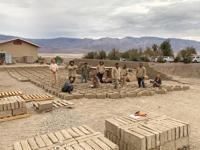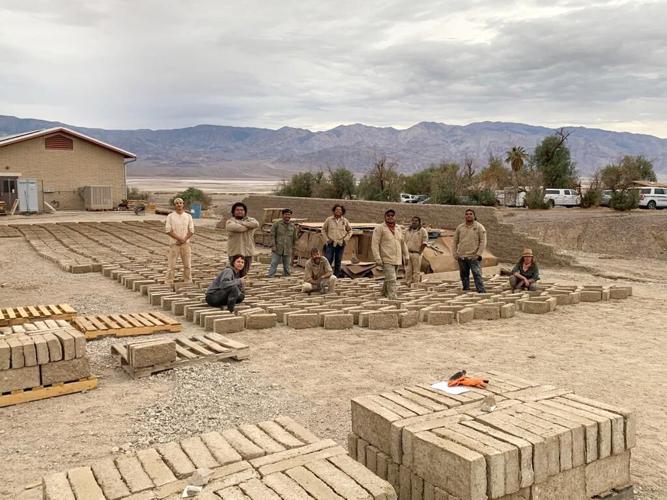A crew of young adults from the Tohono O'odham Nation will work at all five national park sites in Southern Arizona this fall, learning restoration techniques for ruins while being immersed in the culture and history of the region.
The crew will spend two to four weeks each at Saguaro National Park, Organ Pipe Cactus National Monument, Casa Grande Ruins National Monument, Chiricahua National Monument and Tumacacori National Historical Park.
The Arizona Conservation Corps began operating a Tohono O'odham crew in 2018, with members working from September through March on traditional O'odham lands in partnership with the National Park Service and U.S. Forest Service.
Crew members complete restoration work on trails, rivers and traditional sites. They also inventory resources, build fences, educate the public and help visitors understand the site's significance and learn its story.

"They'll spend part of the time helping to restore ruins and doing adobe restoration work, and a variety of other projects," said Lee Gault, director of partnership development for Arizona and New Mexico's conservation corps. "Each project with each park is a little different."
"Historical ruins are suffering degradation because of climate change," Gault explained. "With the heat and floods that come with intense monsoons, the ruins get beat down."
The parks are losing expertise when it comes to historic preservation, with staffing shortages and employees retiring or switching fields, he added.
Pathway to careers
The Tohono O'odham crew is part of the corps' Indigenous Communities Program, rooted in the culture and heritage of local tribal communities, which includes conservation crews, internships and individual placements into jobs.
The program is open to Tohono O'odham members ages 18 through 25. The experience is intended to create a pathway to a career within the National Park Service.
The crews can either be day crews, which go home each night; overnight crews, which spend a few nights a week camping at their project site; or backcountry crews, which strike out and spend most nights camping in the field.
Each crew is made up of a leader, assistant leader and four members, but every participant develops leadership skills through the process.
"A person will be a member, then come back as an assistant leader the next season, then a leader," Gault said, adding that the group is trying to create capacity within the Tohono O'odham Nation to create its own conservation corps program.
In its three cycles, 18 crew members have completed the program.
While there's funding support from the federal land management agencies to do more than one crew, recruitment has been a barrier so far, Gault said.
The National Park Foundation sets money aside each year, to combat the overall loss in expertise about historic preservation, with one grant supporting service and conservation within park service units.

A crew member applies a capping substance to a ruins wall at Casa Grande Ruins National Monument to keep rain from wearing the wall down from above.
The program is a mix of national park and U.S. Forest Service work, Gault said. A nearly $100,000 grant from the National Park Foundation to Conservation Legacy, the nonprofit that supports the corps, allows for the partnership with the five national park sites. The crew spends the first part of the program working at the national park sites before moving on to Forest Service work.
The second part of this year's program will be spent at Coronado National Forest, with the Arizona Conservation Corps receiving funding to do project work there.
"They'll help with the member experience and get a variety of park service work, but they also get to work with another agency," Gault said. "Each has its own culture and its own mission."
Job opportunities for Native Americans
In June, the Biden administration rolled out guidelines for a new youth service program that would create job opportunities for Native Americans, while increasing their cultural connections to nature through conservation projects on tribal and public land. The Tohono O'odham crew's work on the Coronado National Forest will be one of the first Indian Youth Service Corps projects.
The Conservation Corps is also creating an intertribal crew based in Tucson this year for Indigenous participants from any tribe, even nationally, Gault said.
Two members of the most recent crew are interning with national parks this summer, with one doing interpretation work at Chiricahua National Monument while the other works at Casa Grande.
"Hopefully, because career opportunities are limited on the reservation, this will get them into agency positions that are real careers that pay decent money," Gault said.
As of January, while the nation's unadjusted unemployment rate was 4.4%, the unemployment rate for Native American workers was 11.1%, according to the Brookings Institution, a nonprofit public policy organization.
Before the pandemic, Native Americans had a higher unemployment rate than other racial groups, with a 7.5% rate in February 2020. During the pandemic, the Native American unemployment rate jumped to 28.6%, a level comparable to the nationwide unemployment rate during the Great Depression, Brookings reported.
Gault said the Conservation Corps is working hard to get the word out about the Tohono O'odham program.
"Now that we have some history, word of mouth is our number one recruitment tool. More alumni are able to be a voice and be supporters in the community," he said.

The crew stands among the 1,091 adobe bricks they made under the guidance of Cornerstones Community Partners staff at Death Valley National Park last winter.
"It was awesome"
Kyle Juan was a crew leader last year and is spending his summer interning at Casa Grande Ruins National Monument, mostly in park maintenance.
On the reservation, Juan worked outside, installing fence lines for land owners.
"I've always been attracted to working outside," he said. "One day, I saw a flyer (for the TO crew) and decided to check it out."
Juan said that while he already knew some of the information the crew was taught, the education he received in the program ran deep.
"Knowing there's a different aspect with more structure to it, I really appreciate that," Juan said.
Last year — Juan's first with the crew — he ended up "picking up everything and moving to New Mexico for half the year."
"I had two bags, a bundle, a tent and a pillow. That's it," Juan said. "But from working on cow farms, I'm used to traveling light."
Juan ended up falling in love with Gila Cliff Dwellings National Monument, relishing the opportunity to visit and spend time at a place that's so hidden from civilization.
While he went in as a crew member, organizers saw that Juan was willing to grow, and he quickly moved up to team leader.
"They saw I was outgoing and willing to converse and open myself up and talk with individuals I never met before," Juan said. "I was hesitant on a lot, but they talked me through it and kept me positive and showed me what can be. And it was awesome."
Juan was assigned to lead the trails crew, maintaining trails in different parts of the state.
"There were moments when I fell off and wanted to quit, but my crew pulled me together. We were like a little family unit, really," he said. "The crew would start to break down, but we'd take a moment and talk about how if we got this far, we can get a little further. Once we got that break in and a few laughs, we picked it right back up and got a little further."
Juan said he met "so many good people" on the crew, many of whom he's still in contact with.
While he's interested in returning to work on the parks, he's got a stop to make along the way. Juan was getting ready to apply to join the U.S. Forest Service's Wildland Fire program last year when he'd learned he'd been accepted into the Arizona Conservation Corps program.
"I never looked back," he said of his decision to put off the fire service. "Working in the parks is still my goal, but I know there's so much more I have to do. I can't just jump right into it."
Until then, he's spreading the word on the reservation that opportunities like this exist and are within reach.
"Having that opportunity to do certain things allowed me to push other people into the work, too," Juan said. "That's one of the things I want to push to people from our reservation: Our work is a lot bigger than the reservation. All it takes is one individual's willingness to take that step."









